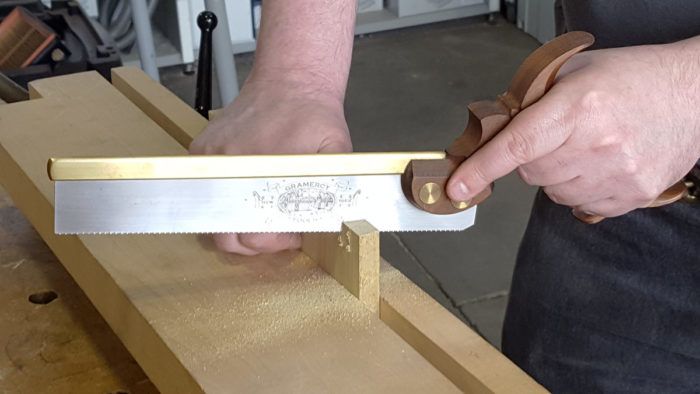History guides Gramercy’s dovetail saw
Open the packaging of one of Gramercy Tools’ dovetail saws, and before you spot a tote or toe, you’ll see something probably unexpected: a sheet of directions
Open the packaging of one of Gramercy Tools’ dovetail saws, and before you spot a tote or toe, you’ll see something probably unexpected: a sheet of directions. The sheet’s full, too. It doesn’t just read “Push sharp saw forward. Pull back. Repeat to line.” Instead, you get nine short paragraphs and six drawings to illustrate use. Now who hasn’t ignored directions for complex electrical appliances and gotten along just fine—or fine enough? The thing is, Joel Moskowitz, owner of Gramercy and Tools for Working Wood, doesn’t find these directions at all weird. Instead, they’re part and parcel of Gramercy’s design choices—choices steeped in Joel’s appreciation for the history of tools and woodworking, as well as its ability to help us today.

From collecting old books (he has a 1683 copy of Joseph Moxon’s Mechanick Exercises) to digging through the records from the Old Bailey—the Central Criminal Court of England and Wales, around since at least 1585—Joel scours history to better inform contemporary woodworking with traditional tools. “They knew some things we don’t,” he says. “Plus, we’ve had less practice.” Hence, Gramercy used 18th-century saws, particularly those in Duncan Phyfe’s tool chest, when designing its dovetail saw. But while Joel would love for Thomas Chippendale to like his saws, his aim is a little lower.
“Imagine you’re a sullen 18th-century apprentice,” he advised when talking about his saw. “You haven’t showered in weeks, and all you want is some bread. Now, cut dovetails.” His point is hand-cut dovetails were historically “apprentice work,” not the precious mark of fine craftsmanship some argue currently. And when it comes to time invested, the average dovetailer today probably has fewer hours under their belt than even a middling apprentice, so Joel’s concerns are with this contemporary crowd, especially the beginners.
“I have a vested interest in lowering the learning curve” for dovetails, he says. He’s found people are willing to spend the money for gear but want results fairly quickly thereafter. “My goal is to get you on the scoreboard faster.” Considering apprentices needed to become proficient fast to be worth their mentors’ while, Gramercy turned to historical examples to study how form followed function. What Gramercy found were “little saws with high hangs,” as Joel describes them. So the team, led by their senior industrial designer, Timothy Corbett, experimented with them—even rigging up a tote with an infinitesimally adjustable hang thanks to a bolt, nut, and washers—before making their own. On the Gramercy saw, each major line on the tote, from the large horn to the long and splayed dolphin tail, echoes the past but is there predominantly to influence your ergonomics, hand position, and ability to guide the saw from the start. Ditto the tooth count, rake, and plate thickness. No aspect is capricious; they’re all there for a deeper reason, most significantly guidance.

Joel advises buyers to ask a manufacturer why they chose that design: Why that ppi? Why that steel? Why that shape? Each choice on a tool is intentional, so if you know its reason, you’ll better know how to use the tool. This is why Gramercy’s dovetail saws come with instructions. “Read the directions,” Joel says. “Use the tool the way it’s intended.” After all, he doesn’t want you to be a sullen apprentice forever.
















Comments
The saw in the photo has a tooth out of line -- either too high or too much set as evidenced by the egregious amount of blowout on the exit side for such a fine toothed saw.
Just curious:
Does anyone think that the handle of this saw is too thin? (those who have actually used it.)
"Just curious:
Does anyone think that the handle of this saw is too thin? (those who have actually used it.)"
Use a very light grip. Let the saw weight do the work. The handle facilitates this. Don't try and grip it with the same strength as saws with thicker handles. Suddenly it comes alive. When you dial this in, it is the best dovetail saw around.
My review is here: http://www.inthewoodshop.com/ToolReviews/GramercyDovetailSaw.html
Beautiful tool, but most hobbyists will opt for something less expensive. At $250 apiece, I could buy a dovetail jig and spare router... just sayin...
Log in or create an account to post a comment.
Sign up Log in